6 Art Therapy Workshop- The Discobolus of Myron
The Discobolus of Myron
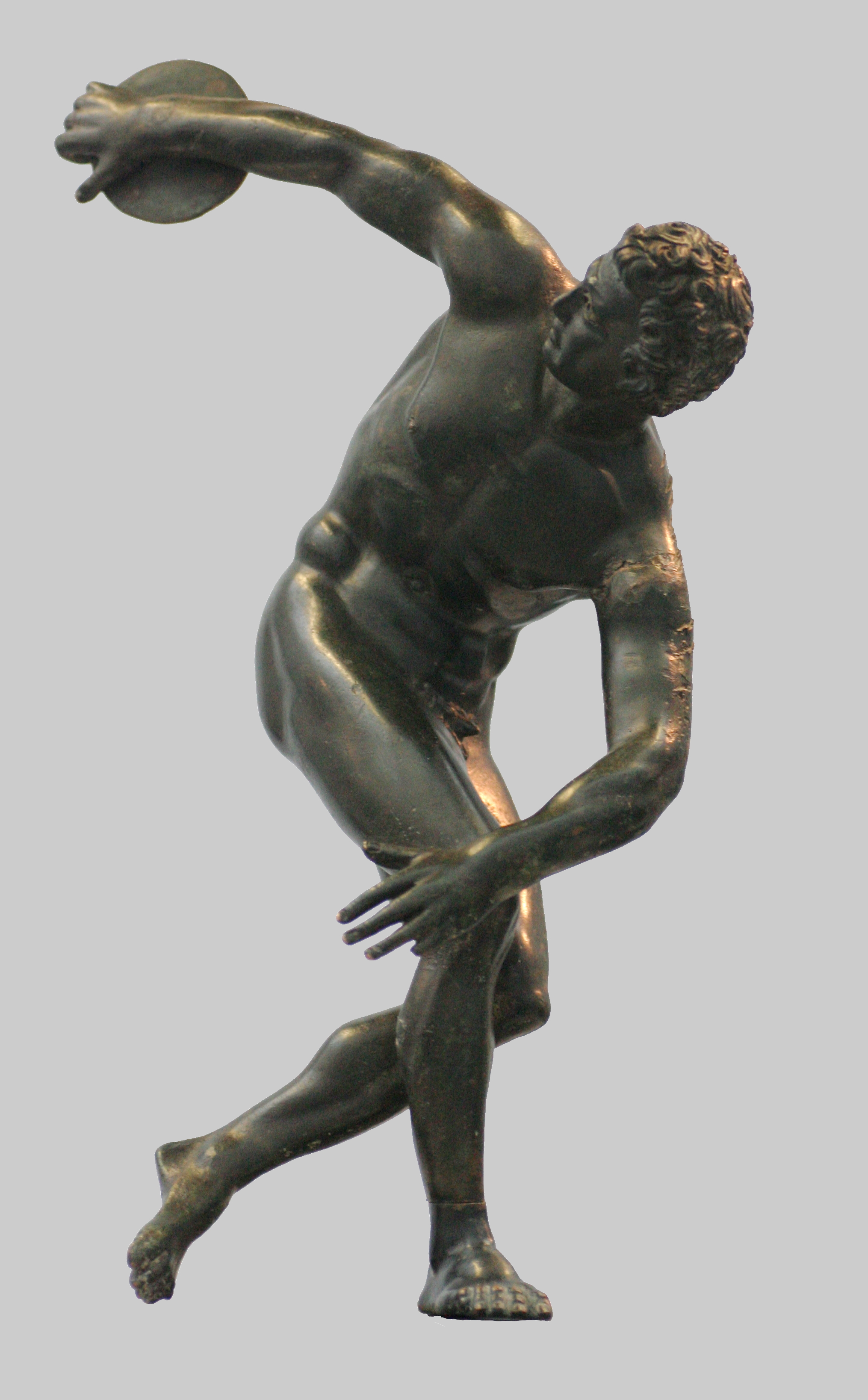
The History of the Discobolus
The Discobolus was first sculpted in Greece around 460-450 BCE by Myron of Eleutherae. Myron was redeemed as a renowned sculptor, known for his depictions of animals. The Discobolus was originally created in bronze, however, this original has never been recovered. The Discobolus stood as a symbol of status, coveted for its astonishing display of human agility and strength. The discus-thrower was also admired for capturing an unmatched representation of proportion, harmony, rhythm and balance. Experts since antiquity have noted how “the fluidity of movement in the body combines with a calm expression on the face, as if the thrower has achieved a perfect state of control in mind, body and spirit”[1].

Despite the loss of the original, numerous replicas have been found, made from marble, plaster, and stone. The “Townley Discobolus’ ‘ was excavated, in 1790, at the Emperor Hadrian’s Villa and was purchased by an English antiquary and art dealer, at public auction in 1792 for £400 for the statue. The head was wrongly restored, as pictured below. It was bought for the British Museum in 1805. The museum does not currently show it.
How Did We Get Here From There?
This trend of powerful figures desiring Greek art did not cease with the ancient world. The Venus de’ Medici was loved by Napoleon[2], and the discobolus was loved by Adolf Hitler[3]. The “Discobolus Palombara”, Hitler’s Discobolus, was found in 1781 at a Roman property of the Massimo family at the Villa Palombara on the Esquiline Hill.. In 1937 Adolf Hitler negotiated to buy it and eventually succeeded in 1938. The Italian Minister of Foreign Affairs sold it to him for five million lire, over the protests from the scholarly community. It was shipped to Munich and displayed in the Glyptothek. It was returned in 1948 and is now in the National Museum of Rome, displayed at the Palazzo Massimo.
The 5th Century BC had long been considered the golden age of Classical Greek history.
Hitler was attracted to this period as a whole. In addition, he wished to champion the values that he believed the sculpture embodied – ideals of harmony, athletic vigor and beauty – in opposition to Modernist art, which he castigated as “degenerate”. A quote to articulate how the nazi ideals were placed onto the discobolus that I like is as follows: “Like all hunters, they hunted for a priceless object – and as the statue could not say no, they used the Discobolus for their perverse ideologies. The perfect Aryan body, the white colour [of the marble], the beautiful, ideal white male: to put it very bluntly, it became a kind of image of the Herrenrasse or ‘master race’ – that’s what the Nazis called themselves and the Germans”, Professor Rolf Michael Schneider of the Ludwig Maximilian University of Munich[4].
![Olympia Part One: Festival of the Nations [Olympia 1. Teil - Fest der Völker] - movies - onderhond.com](https://onderhond.com/img/posters/olympia-1.jpg)
The discobolus was cemented as a figure of the Nazi regime when Leni Riefenstahl directed Olympia – Festival of Nations (1936), for the Berlin Olympics. The film begins in greek ruins, and short clips of varying greek statues. This montage ends on the discobolus as it then morphs into a German athlete, cementing the idea that the Germans are direct descendants from the Greek empire. Reincarnates in power. The Olympic torch is also seen being lit, within the Greek ruins, and a German athlete then runs the fire directly to Berlin. This act ties the Third Reich to Ancient Greece, symbolically and literally.
Moving Forward- The Positives and The Negatives
Despite the return of the Discobolus to Rome, this statue, and ancient Greek artifacts, remained as a symbol of power for the elite. In the United States, wealthy people have collected antiques as a symbol of status.
Walter and Elise Mosher were wealthy art collectors in the LA area. Over the course of 10 years,
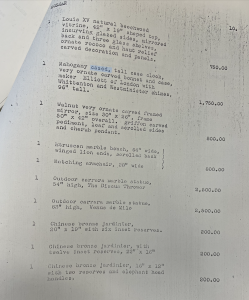
they donated their entire art collection to Pomona College’s Benton Museum. Among the donations was a discobolus replica.
This discobolus now sits to this day, in a vault here at Pomona College’s Benton. While we can’t be certain the reasoning for the Mosher’s original acquisition, we know that like most collectors of this time period, it was a symbol of status, and perhaps a familiar passion for ancient Greek relics. We do know for a fact that Benton chooses to not show this piece, yet also chooses to not rid themselves of its history. This is where our workshop comes into play to heal our academic relationship with the statue.
ARt Changing Our Perception
I don’t believe that disposing or removing the statue from the Benton’s collection will do more good than harm. In fact, I think that this act of sweeping the discobolus’s history under the rug is a greater injustice than keeping it in the collection. This is not the first statue to live on the 5c campuses with a dark, specifically nazi history. The “Young Women”, a statue standing in Scripps College’s Tiernan Field House, was created by the Nazi artist Georg Kolbe. In February of 2022, a TSL article was released calling for the removal of the sculpture[5]. Today, it still stands, without as much as an updated placard with its history. This statue, along with the Discobolus are why I proposed this workshop, and why we are here today. My aim is to address this history in an informative environment. I acknowledge that in many cases, the only solution is to remove a piece that immortalizes violence and trauma. However, we are a learning community. We have the ability to hold ourselves accountable for learning about the past of statues that the administration refuses to remove. As a classics department, we have the choice to pretend that the poets we study don’t have their own dark sides. We can acknowledge Greek art’s role in history without perpetuating the pain and violence that it carries. In the workshop, I aim to walk you through what this piece evokes with and without its history attached. I have chosen art as an avenue for this workshop because we are working with a historic piece of art. Art therapy is a practice that therapists are beginning to use to “help patients interpret, express, and resolve their emotions and thoughts”[6]. Patients work with an art therapist to explore their emotions, understand conflicts or feelings that are causing them distress, and use art to help them find resolutions to those issues.
“Art is healing because it forces you to forge a connection between your mind and your body”,[7].
This workshop is just the beginning of a very long conversation we as a college must continue to have with the artifacts we surround ourselves with. Healing art with art.
The Workshop
While I supply directions and questions for how to complete the Discobolus workshop, do not be afraid to venture outside these guidelines. The practice of using art as therapy is still be researched and defined, which gives us the artistic license to interact with this workshop at our enjoyment.
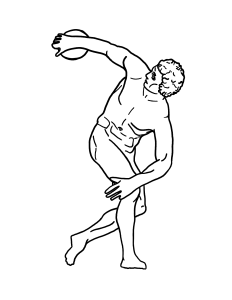
Supplies needed for conducting the workshop:
- Art materials of your choice, Crayons, markers, paint, collage, etc.
- Rendition of the Discobolus on paper.
- Questions for engaging.
- An open mind.
Instructions for conducting the workshop:
- Gather supplies and set yourself up in front of the Discobolus. (Can be in person or online)
- Print out physical copy of workshop. (find pdf here: Discobolus workshop)
- Read through reflection questions.
- Allow yourself artistic/academic/creative freedom to explore what these questions and the discobolus spark inside of you.
- Upload your finished reflection here: https://drive.google.com/drive/folders/1A3-KSbxSo8grGiQOW0bM2T-M28EZwG6W?usp=share_link
6 Questions for conducting the workshop:
- What is your first reaction to the discobolus? Immediate, knee jerk, unfounded, reaction to this statue?
- Can you separate this piece from its history? Why or why not?
- How can you create a narrative of further entangling this piece with its history in your art?
- What location do you imagine this piece living in? Where would it be the most useful? The most destructive?
- What do you find beautiful about the Discobolus? If you don’t, why not?
- Does it bring out a certain emotion that you can identify with? If you can’t, is there another way to articulate the way it feels?
Feel free to use color, shape, words, sounds, etc. in your practice of healing the art today.
Examples from completed workshops:
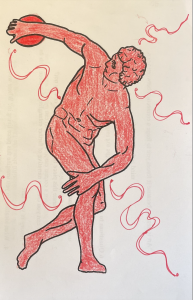
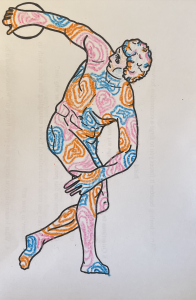
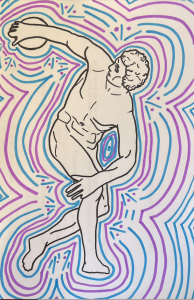
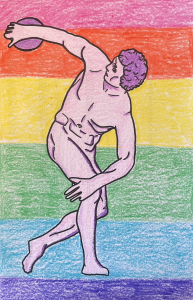
References:
- Butler, Simon. “The Discobolus.” Hidden History, 14 Oct. 2020, https://www.hiddenhistory.co.uk/2017/03/28/the-discobolus/. ↵
- Kotseli, Areti. “The Marble Statue of Medici Venus Once Had Impressive...make-Up.” GreekReporter.com, 26 Jan. 2021, https://greekreporter.com/2012/03/11/the-marble-statue-of-medici-venus-once-had-impressivemake-up/. ↵
- “The Discobolus: Greeks, Nazis and the Body Beautiful.” BBC Culture, BBC, https://www.bbc.com/culture/article/20150324-hitlers-idea-of-the-perfect-body. ↵
- Bahadur India-born, Published by Tulika, et al. “Discobolus of Myron.” On Art and Aesthetics, 26 Sept. 2020, https://onartandaesthetics.com/2016/04/12/discobolus-of-myron/. ↵
- Dunkin, Lily. “Opinion: Nazi Associations of Scripps Statue Call Into Question College's Commitments to Inclusivity.” The Student Life, 15 Feb. 2022, https://tsl.news/opinion-nazi-associations-of-scripps-statue-call-into-question-colleges-commitments-to-inclusivity/. ↵
- “What Is Art Therapy?” Psychology.org | Psychology's Comprehensive Online Resource, 17 Aug. 2022, https://www.psychology.org/resources/what-is-art-therapy/. ↵
- “The Healing Power of Art.” Henry Ford Health - Detroit, MI, https://www.henryford.com/blog/2018/05/healing-power-art. ↵

